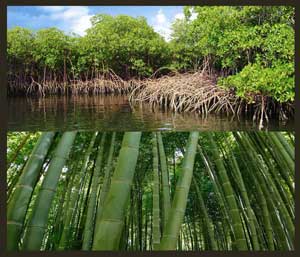DENR, UP INK PARTNERSHIP FOR INTEGRATED AREA DEVELOPMENT
The Department of Environment and Natural Resources (DENR) and the University of the Philippines (UP) are joining hands to create models of integrated area development at the Ninoy Aquino Parks and Wildlife Center (NAPWC) and UP Diliman campus, which are both located in Quezon City.
The collaboration was formalized through a memorandum of understanding (MOU) recently signed between DENR Secretary Gina Lopez and UP Chancellor Michael Tan, together with UP Vice Chancellor for Community Affairs Nestor Castro.
"I feel that the DENR can offer UP an exciting arena where they can parlay their educational know-how, their skills, including community development," Lopez said.
"I am looking here at architecture, community development, engineering, housing and economics. The things are exciting," she added.
Lopez expressed optimism the partnership will turn out well and serve as a model for community development that can be replicated in other areas in the country.
"If it's good for DENR and it's good for the university, it's also very good for the country," she said.
Identified as an area for development is the 25-hectare NAPWC, which Lopez plans to transform into an "ecological paradise" and a tourist attraction.
She said that an "innovative environmental technology" will be put up in the park to serve as a learning ground for communities and local government units across the country.
Meanwhile, Lopez said the UP Arboretum will also be an extension of the educational experience.
Under the MOU, the DENR and UP "shall share, coordinate and combine technical, management, financial and physical resources to pursue research and development, and engage in continuing top-level and technical consultations and multi-disciplinary expert technical assistance."
Both parties also "agree to collaborate to create models of integrated area development (IAD) in the pursuit of social justice and human development."
Chancellor Tan said the undertaking will show that environmental conservation and sustainability can be very compatible with the other needs of the university.
Aside from the budget to be infused by the DENR, Tan said that UP will also provide a financial counterpart.
Lopez is determined to prove that through IAD, the projects that will be developed and implemented will benefit the people who live in the areas. In the process, these areas will serve as models of entrepreneurship.
"It's about creating models. Pwede pala, kaya pala natin," Lopez said.
The MOU also provides that the parties will "undertake projects with consideration on solid waste management, clean air, clean water, biodiversity and the Expanded National Greening Program (ENGP) through the planting of trees and bamboo."
Lopez described the partnership as a great collaboration between the government and the academic community.
Confident on the success of the partnership, Lopez said the DENR will also embark on similar undertakings with other state universities throughout the country. ###
- Details
- Parent Category: News & Events
- Category: Press Releases



